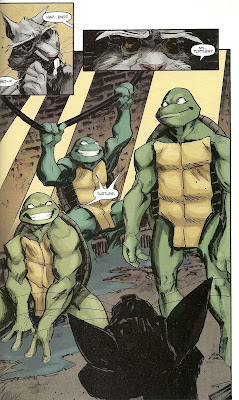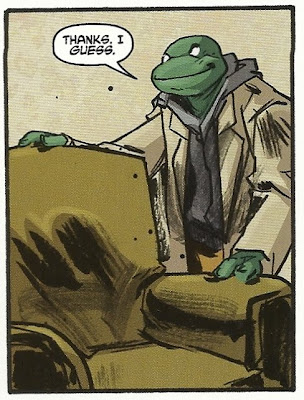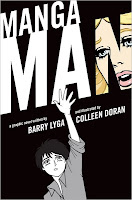
This is the first trade paperback collection of publisher IDW’s new Teenage Mutant Ninja Turtles comic, a licensed comic book they are producing on behalf of the turtles’ new owners, Nickelodeon. The title reads
Teenage Mutant Ninja Turtles, but Diamond shipping lists call it
Teenage Mutant Ninja Turtles Ongoing.
This trade collects the first four issues under the title “Change is Constant.” It is written by Kevin Eastman and Tom Waltz, with the pair providing the story and Waltz the script, and the artwork is by Dan Duncan, atop layouts by Eastman. So essentially one of the original cartoonists responsible for creating the turtles is writing and drawing this new series, although it’s simultaneously being written and drawn by others as well.
*********************
I really like the turtles characters.
A phonebook-sized paperback collection of the first chunk of the original series and the brand-new issues from later in the first volume of that same series were among my “gateway” comics into the medium. I have enormous affection for those original comics and those original interpretations of the characters.
That said, I was very excited about this new series, in no small part because of Eastman’s involvement. It was certainly a surprise. Over the course of the previous decade or so, Eastman had been largely divorced from the franchise, and sold his share of the property to his former partner Peter Laird and Mirage Studios in 2008. Laird was the one heavily involved with Mirage Publishing during that time, and if one of the original creators was going to be involved in the creation of a new series, I would have expected it to be Laird.
I was pleased to hear that IDW would be essentially rebooting the characters and their story, rather than continuing it where Mirage had left off. Laird and company kept their last volume of their series as a continuation of those previous, and it had gotten pretty weird by the time I stopped reading it (which was a few years before they ceased publication). The turtles were at that point living in a world where mutants, superheroes and aliens were all living openly among Earth society.
I liked it okay, but eventually found myself less excited about each new issue, and figured I’d drop the monthly and catch up on trade someday (Although I’ve yet to attempt to do that).
I was interested to see what a fresh, new take would be, then, and how Eastman would approach a do-over of what has become his life’s work given the opportunity, and with the hindsight of what worked and didn’t work back then, and what has and hasn’t worked from other creators and in the turtles stories of various other media.
**********************
As much I was looking forward to reading IDW’s TMNT, I didn’t want to read it in singles.
IDW charges $3.99 for their comic books, which I think is way too much money to charge for a single issue of a comic book. It seems less
evil when IDW does it than when Marvel or DC does it, given that IDW is a smaller company and they don’t have the millions and billions of a parent corporation behind them, nor do they make their “real” money in licensed merchandise and cartoons and film the way the Big Two do.
In other words, when Marvel and DC do it, they do it because they know they can, and are pretty open about the fact that they charge more money because they
want more money, not because they
have to.
Still, if I’m going to put four-fifths of a five-dollar bill into reading a chunk of a comic story, I’d prefer to put it toward something permanent with a spine that I can stand on a bookshelf, rather than have to add to my midden of longboxes.
Additionally, IDW’s TMNT had variant covers for these issues, and they are pretty great variant covers. In addition to covers by Eastman, which help this collection
look like a good old-fashioned issue of
Eastman and Laird’s Teenage Mutant Ninja Turtles and covers by Duncan, they
also shipped covers by such perfect-for-the-turtles artists as Fred Hembeck, Sam Kieth and Walt Simonson.

Who would want to buy the singles and have to choose between, say, an Eastman and a Hembeck? The collection has them all in the back.
So that was two votes in favor of reading this series in trade, even if at $18 its slightly more expensive than reading the series in singles.
***********************
In lieu of a formal review, I have some thoughts about the book.
*********************
There are a lot of familiar names here. In addition to Splinter and the turtles, there’s a Casey Jones, an April O’Neil, a Baxter Stockman and a Krang. These names are all attached to characters who, so far at least, seem to be the same, although they’ve been reorganized pretty drastically.
Splinter (whose name choice is here justified so as to distance the mutants’ origin from that of Marvel’s Daredevil) and the four turtles are lab animals in a research facility run by Stockman. April interns there. A general named Krang has hired Stockman to deliver military applications derived from the work on the animals. Some ninjas are also interested.
Meanwhile, there’s a teenage boy named Casey Jones who is abused by his alcoholic father and blows off steam by wearing a mask and hitting purse snatchers with a baseball bat. He doesn't seem to be as insane as in the original
TMNT comics.
The story opens as Eastman and Laird’s first issue of the first turtles opened, with the TMNT about to fight a gang of thugs.
What’s different here is that the human thugs are lead by Old Hob, a mutant cat created in the same accident that created Splinter and the turtles.
And instead of the four turtles, it’s Splinter, Leonard, Michelangelo and Donatello. Raphael was separated from the turtles when they were first exposed to the mutagen, and thus didn’t grow up with them.
The narrative then jumps back to recount their life in the lab and their origin story, and then back and forth between the two story threads as they progress. In the present, an amnesiac Raphael wanders the streets alone, while Splinter has the other turtles searching for their lost brother.

The first flashback begins with a box reading “Eighteen Months earlier,” and, as I read on, I assumed that must have been a typo, as it then showed the turtles as actual, non-mutant turtles.
Had only eighteen months passed between the time they were normal turtles (and a normal rat…although Splinter’s brain was being expanded by science before his body mutated) and the time they are ninja masters?
Surely, they meant
years and not months, right?
But later captions bear that timeline out: The teenage mutant ninja turtles have only
been mutant ninja turtles for a matter of months, rather than years, which, well
that doesn’t work.
Look, I realize how silly it is to get hung up on something in a comic with
that particular title being “unrealistic,” but if I’m going to buy teenage mutant ninja turtles, don’t
also ask me to believe it only takes a couple of months to become a ninja.
Hell, the word “teenage” is right there in the tile. It’s a component of the weirdo magic formula that makes this one-time lark
work, you can’t remove that aspect and have it work the same (I think that likely explains some of
the confused and irritated reaction to news that Michael Bay was considering making his turtles aliens. It’s not so much the change to what fans already know and expect so much in that if they’re aliens then they aren’t mutants, and that violates the four-word formula. That, and the fact that it’s Michael Bay doing it, of course).

In the time it takes most human beings to learn to walk and just begin to talk, the turtles are…the ninja turtles already. That seems strange in and of itself, without factoring in the martial arts training and weapon proficiency they’ve developed.
*********************
By changing the origin story a bit, they’ve also excised the explanation for how the team got its ninja skills. Originally Splinter was a pet rat kept by a ninja master, who learned martial arts by observing and imitating his human master. When he escaped and mutated, he was thus able to pass those skills on to his pupils, the turtles.
Here though, Splinter seems to have been born and raised in a lab and not exposed to any ninjitsu, so it’s unclear where he learned to fight (At least by issue #4). And if Splinter
did know martial arts from sometime in his own past, before the lab started tinkering with his mind, he didn’t have time to pass those skills on to his students, nor would he have been able to train Raphael at all, since Raphael spent that time away from him.
***********************
The turtles are now sea turtles.
That’s a pretty small change…
or is it?!
I suspect it was simply an art mistake, that Davis chose to draw them with flippers instead of feet while he was drawing the page, rather than the script specifically calling for a particular type of turtle. They’re drawn in a little aquarium with only a little pool of water:

While sea turtles do breathe air and can kind of move around on dry land half-assedly, they spend the majority of their lives submerged, and only leave the sea to lay their eggs.
So what happens when a
sea turtle evolves into humanoid form, as opposed to a land turtle super-evolving into a humanoid? Would the former evolve so much that they no longer need to be submerged in water? That they can live their whole lives on dry land? (Part of me here is sorely tempted to spend a few paragraphs discussing the rules for creating mutants as proposed in
Palladium Games' Teenage Mutant Ninja Turtles and Other Strangeness and After the Bomb role-playing games, and how it would expend much more energy mutating a sea turtle than a land turtle, and how that would spend more life energy that could otherwise be spent on giving your character particular skills and proficiency, but I have to set a nerdiness limit for myself, and I think a long tangent about an RPG
in the middle of a discussion about a comic book would probably be pretty far on the other side of any self-imposed nerdiness limits).
Davis’ turtles, once mutated, lack tails, but that’s the only physiological difference I can see. The turtles still have tails on Eastman’s covers, though.
*********************
(Friends and family would always comment on the ninja turtles's tails when I drew them as a teenager, thinking that they were supposed to be penises instead of tails. Rarely would anyone look over my shoulder to see me drawing a ninja turtle and fail to point to the tail between their legs and ask, "What's
that supposed to be?")
*********************

Oh, the turtles don’t have pupils, either. In the original comics, they had pupils in their eyeballs when they weren’t wearing their ninja masks, but when they put their masks on their pupils disappeared, Batman-style.
********************
I'm not entirely sure how I feel about the book being in color. The turtles are one of the very few comics that seem like they
should be in black and white, as black and white comics are their original habitat. Whenever I see them in color, in those original First Comics collections, or the few color specials, or Archie Comics or wherever, something tends to feel off about it, like color is a
Wizard of Oz signifier, drawing a line between the "real" (comic book) turtles and the other, "fake" (cartoon) turtles.
Again, that's maybe just me.
The coloring in this book was fine, though and much better than in IDW's
Raphael #1, which was my only previous experience with their caretaking of the franchise so far (I wrote at length about it
here, if you'd like a much more cogent piece of my writing about IDW's TMNT. Which isn't to say that the piece is terribly cogent, only that it's a lot less formless than this one is).
********************
I thought it was okay, beyond the problems outlined above, and most of my difficulties with the book come down to the "That's not how
I woulda done it" variety (TMNT comics are probably the only remaining comics that I still can look at with that frame of reference, I used to want to do turtle comics so badly. I would have preferred to see this series start well after the basic origin, and dwell instead on the characterization and the relationships, with plots centering around new adventures instead of a rebooted origin. But, again, that's me).
The Casey Jones bits felt pretty forced to me, and I'm not sure how he's going to end up fitting into the cast, nor do I see how Raphael is supposed to fit after having grown up apart—the others only got about 15 months worth of training, but that's still 15 months more than him, right?
I really liked how different the art was from what I might have expected a ninja turtles comic to look like, and how different it was from Eastman and Laird and Jim Lawson's (Lawson being the artist who has probably drawn more turtles pages than anyone else at this point, including work on the previous volume of the series).
I do want to see what they end up doing with the characters, and how the cast will eventually shake out. It seems like there’s a bit of a way to go before everything falls into place yet.
**********************
I’ll buy and read Volume 2.
 This is a neat little book, particularly for people who love books. Hell, if you saw that cover and thought, “Neat,” chances are it’s a book you’ll enjoy reading.
This is a neat little book, particularly for people who love books. Hell, if you saw that cover and thought, “Neat,” chances are it’s a book you’ll enjoy reading.  Check out that conastoga wagon thing with the electric cord and plug coming from it. What the hell is that? A crazy lamp? A plug-in Wagon Train playset? Price doesn’t ask her.
Check out that conastoga wagon thing with the electric cord and plug coming from it. What the hell is that? A crazy lamp? A plug-in Wagon Train playset? Price doesn’t ask her.  The only comic book in there is a Tintin volume, although Edward Gorey tends to haunt an area just across the border of comics.
The only comic book in there is a Tintin volume, although Edward Gorey tends to haunt an area just across the border of comics. 







































